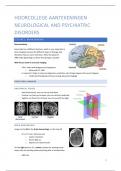Class notes
Lectures Neurological and Psychiatric Disorders (AB_1023) (minor Biomedical Topics in Healthcare)
- Course
- Institution
Notes of all the lectures given during the course Neurological and Psychiatric Disorders (minor Biomedical Topics in Healthcare). The document also contains many useful images that match the explanation of the course material. (vak voor o.a. gezondheidswetenschappen, gezondheid en leven, biomedisc...
[Show more]




